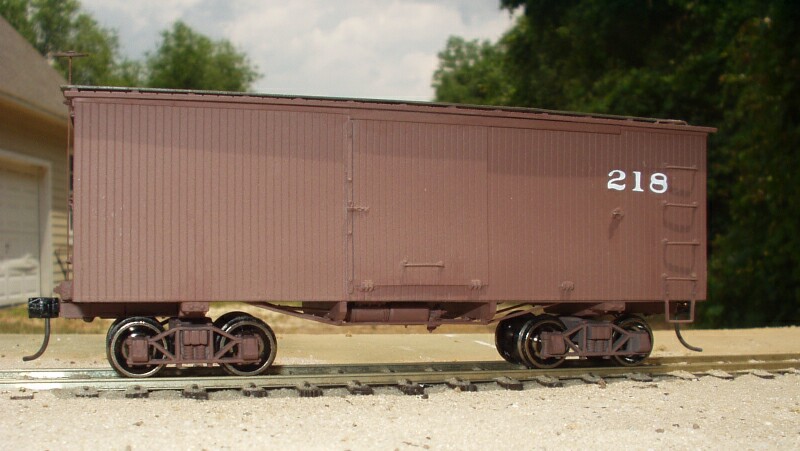By John L. Adams
The Chicago, Bellevue, Cascade & Western Railway Company was organized in 1877 and its 36 miles of 30 lb. iron arrived in Cascade Iowa, a town of 900 souls, on the evening of December 31, 1879. The celebration on New Years Day 1880 was attended by over 5000, as the arrival of the railroad and all its associated benefits was a big deal back then. The CBC&W’s eastern terminus was at Bellevue, Iowa, on the Mississippi River, where it interchanged with the standard gauge Chicago, Clinton, Dubuque & Minnesota Railroad, known as the “River Road,” its parent company. The River Road ended up being acquired by the Chicago, Milwaukee & St. Paul in late 1880 causing “the Gauge,” as it was known locally, to be called the “Milwaukee Road Narrow Gauge.”
As the line headed west out of Bellevue it passed the unofficial station of Paradise. It was a concession for right of way through the Paradise Valley Farm before assaulting the big hill to Summit. Most of the west bound trains had to double this hill and the one outside of Bernard. The road had a number of stiff grades; one was an uncompensated 2.8%, as well as curves as tight as 12 ½ degrees. These features were the main reason that the line was never standard gauged. After cresting the Summit, the first official station was LaMotte, and then came Zwingle, Washington Mills, Bernard, Fillmore and finally 3 hours and 5 minutes after departing, the Up train arrived in Cascade. On the timetable the Down train was scheduled for a 3:45 trip to give the brakemen time to set the handbrakes before descending the hill. As best as I can tell, the line had fewer than 40 switches, including one stub switch at LaMotte served to the end. The line had two turntables and a coaling station at Washington Mills that is a dead ringer for the branchline coaling station by Al Armitage in the July/August 1983 Narrow Gauge & Short Line Gazette.
The farming communities of Jackson and Dubuque counties depended on the Gauge to get their produce to the markets of Chicago and the rest of the nation. There were five grain elevators in the six towns west of Bellevue and at least as many stockyards, all wanting immediate shipment in the 48 boxcars and 38 stockcars the line owned, all of which were 24-footers of 10 and 8 ton capacity respectively. The rest of the rolling stock included twelve flats, sixteen gons, two UTLX tank cars leased in 1916, one thirty-foot caboose, one coach and three combines, one of which had an RPO section. The Gauge ran this way till it was scrapped in 1936.
 The “Ox” at Zwingle, Iowa, 1936
The “Ox” at Zwingle, Iowa, 1936
Iowa’s “slim princess” had as eclectic a mix of motive power as could be desired; two or three Pittsburgh 4-4-0’s, a Brooks Mogul, a Cooke Consolidation formerly #55 of the Colorado Southern (which explains why BLI had their one of their On30 C-16’s with a Milwaukee Road herald on the tender), two Baldwin outside frame 2-6-0’s, an unsuccessful yellow rail bus called “The Canary,” and a 20 ton Plymouth “infernal” combustion switcher called “The Ox.” The MOW lineup included a pile driver, a wedge snowplow, a slope leveler, a self-propelled Burrow crane, two air dumps, a bunk and kitchen car and a truly unique snow blower called a Sno-Go built by Klauer Mfg. Co. in 1929 and powered by two Climax engines of 4 and 6 cylinders.
In 1880 there were 7 narrow gauge railroads in Iowa. The demise the last narrow gauge in the state came with the advent of the automobile, trucks and better roads. Ironically the narrow gauge hauled fuel for the vehicles and the building materials for the paved roads.
Other Midwestern Narrow Gauge Lines
For the modeler there were quite a few narrow gauge lines in the Midwest beside the seven in Iowa. There were several in Minnesota including 1 running to the Twin Cities. Wisconsin had the C&NW lines in south west part of the state, the Dinky with its 2 horseshoe curves, one of 250 radius, ran till 1926. The CB&Q owned quite a few narrow gauge roads, most people know of the line in the Black Hills but there was also the Fulton County Narrow Gauge running 61 miles between Galesburg and the Illinois River at Havana. The FCNG accounted for only 16% of Illinois narrow gauge tracks. It ran mainly Baldwin 8-18 4-4-0’s with passenger cars by Jackson & Sharp. This line was widened all in one day, Saturday, October 15, 1905.
There is a lot of narrow gauge variety out there for the adventurous soul that isn’t afraid to do a little research and scratchbuild their own cars. The Bachmann and MMI 4-4-0s will go a long way in providing motive power to these turn-of-the-century lines.
References:
“Milwaukee Road Narrow Gauge”, John Tigges and Jon Jacobson, Pruett Publishing, 1985
“Narrow Gauge and Short Line Gazette”, July/Aug, Sept/Oct, Nov/Dec 1979, Albin Lee
“Bulletin 61A”, E. W. Mureen, The Railway & Locomotive Historical Society, Inc., 1988
“The Dinky”, Greg Condon, Robert Felten, James Nickoll, Marsh Lake Productions, 1993



